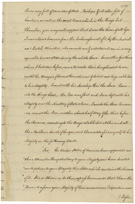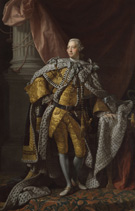Personal Encounters
John Adams - Audience with King George III, 1785
On July 4, 1776, John Adams, delegate to the Continental Congress from Massachusetts, voted to adopt the Declaration of Independence, proclaiming the British King unfit to be ruler of a free people. The King had proclaimed the rebellious colonists to be traitors. Could Adams possibly have imagined that, after eight years of warfare, he would stand before that same King, as a respected diplomat on the world stage, presenting his credentials as the first United States Minister Plenipotentiary to Britain?
On June 1, 1785, King George formally received John Adams, representative of the fledgling nation that had dealt the British Empire a bitter defeat. The meeting, as Adams recounted in this official account, was marked by the pomp and ceremony required by the occasion of a royal audience. But beneath the pageantry, Adams described a strong undercurrent of emotion as the King and his former subject—who once reviled each other as bitter enemies—met face to face, as statesmen.
Letter from John Adams, Minister to Britain, to John Jay, Secretary of State, reporting on his audience with the King, June 2, 1785, page 478
John Adams arrived in London on May 26, 1785, to assume the post of the first United States Minister Plenipotentiary to Britain. Less than one week later, he went to St. James Palace to present his credentials to the King.
This letter is Adams’s official report on that extraordinary meeting. It includes the remarks that Adams made (a speech he had rehearsed and committed to memory) and, as best as he could remember, the words spoken by the King in reply.
National Archives, Records of the Continental and Confederation Congresses and the Constitutional Convention
Excerpt:
John Adams’s remarks to King George III
“Sir, The United States of America have appointed me their Minister Plenipotentiary to your Majesty . . . It is in Obedience to their express Commands that I have the Honor to assure your Majesty of their unanimous Disposition and Desire to cultivate the most friendly and liberal Intercourse between your Majesty’s Subjects and their Citizens . . . The appointment of a Minister from the United States to your Majesty’s Court, will form an Epocha in the History of England & of America. I think myself more fortunate than all my fellow Citizens in having the distinguished Honor to be the first to stand in your Majesty’s royal Presence in a diplomatic Character . . .”
.
Letter from John Adams, Minister to Britain, to John Jay, Secretary of State, reporting on his audience with the King, June 2, 1785, page 479
John Adams arrived in London on May 26, 1785, to assume the post of the first United States Minister Plenipotentiary to Britain. Less than one week later, he went to St. James Palace to present his credentials to the King.
This letter is Adams’s official report on that extraordinary meeting. It includes the remarks that Adams made (a speech he had rehearsed and committed to memory) and, as best as he could remember, the words spoken by the King in reply.
National Archives, Records of the Continental and Confederation Congresses and the Constitutional Convention
Excerpt:
Response of King George III
“I wish you Sir, to believe, and that it may be understood in America, that I have done nothing in the late Contest, but what I thought myself indispensably bound to do, by the Duty which I owed to my People. I will be very frank with you. I was the last to consent to the Separation, but the Separation having been made and having become inevitable, I have always said, as I say now, that I would be the first to meet the Friendship of the United States as an independent Power. . . let the Circumstances of Language; Religion and Blood have their natural and full Effect.”
.
Letter from John Adams, Minister to Britain, to John Jay, Secretary of State, reporting on his audience with the King, June 2, 1785, page 480
John Adams arrived in London on May 26, 1785, to assume the post of the first United States Minister Plenipotentiary to Britain. Less than one week later, he went to St. James Palace to present his credentials to the King.
This letter is Adams’s official report on that extraordinary meeting. It includes the remarks that Adams made (a speech he had rehearsed and committed to memory) and, as best as he could remember, the words spoken by the King in reply.
National Archives, Records of the Continental and Confederation Congresses and the Constitutional Convention
.
George III, oil painting by studio of Allan Ramsay, London, England, ca. 1770
Courtesy of Colonial Williamsburg Foundation, Williamsburg, Virginia
.



